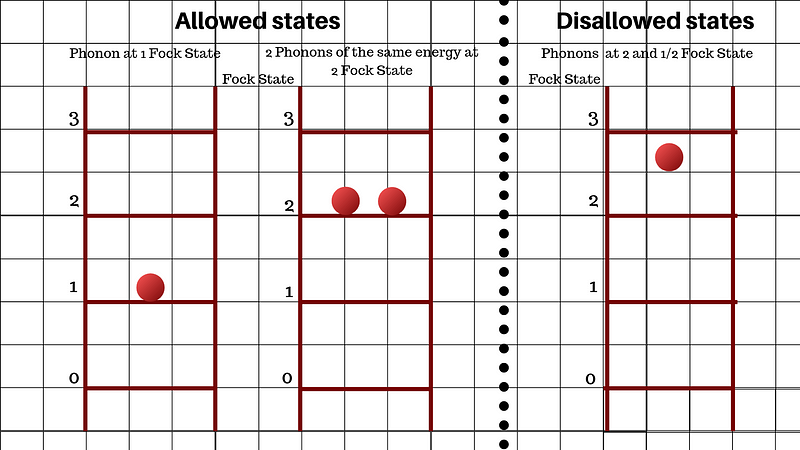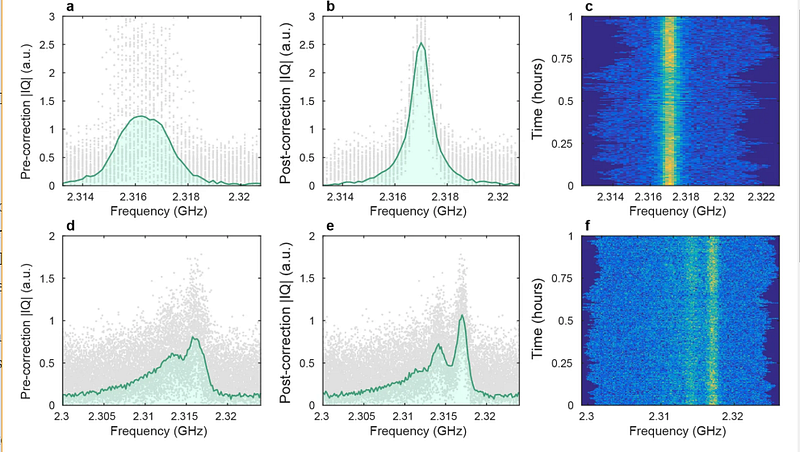A device that eavesdrops on the quantum whispers of atoms and records particles of sound — phonons — could form the basis of a new type of quantum computer.

Artist’s impression of an array of nanomechanical resonators designed to generate and trap sound particles, or phonons. The mechanical motions of the trapped phonons are sensed by a qubit detector, which shifts its frequency depending on the number of phonons in a resonator. Different phonon numbers are visible as distinct peaks in the qubit spectrum, which are shown schematically behind the resonators. (Wentao Jiang)
Physicists at Stanford University have developed a microphone so sensitive that it can measure the individual ‘particles of sound’ — phonons.
The device —described as a ‘quantum microphone’ — could lead the way to smaller, more efficient quantum computers which operate by manipulating sound instead of light.
Amir Safavi-Naeini, an assistant professor of applied physics at Stanford’s School of Humanities and Sciences, led the study — published in the journal Nature. He says: “We expect this device to allow new types of quantum sensors, transducers and storage devices for future quantum machines.”
A quantum of sound
It was Einstein who first proposed the existence of phonons — packets of vibrational energy emitted by perturbed atoms — in 1907. These indivisible packets of energy — quanta — work on the same principle as that which formed the foundation of quantum mechanics. This principle suggested that photons — particles of light — come in specific packets of energy also known as quanta.

Picturing the Fock states — the energy levels of phonons — as rungs on a step ladder. A phonon can exist at step 1 or 2, but not at step 2 and 1/2. (Lea)
The consequence of all this is that the vibrational energy of phonons is restricted to discrete values. To simplify this, imagine a ladder with the rungs acting as the energy levels of phonons. It is possible for a phonon to sit on rung 1 or rung 2, but it is impossible for a phonon to sit on rung 1 and 1/2 or 2 and 3/4.
The equivalent of the steps in our analogy for phonons are known as Fock states — the representation of energy levels in mechanical systems — numbered 0, 1, 2, 3, upwards. A 1 Fock state consists of 1 phonon of a particular energy. A 2 Fock state, two phonons with the same energy and so on.
Safavi-Naeini continues to explain: “Sound has this granularity that we don’t normally experience.
“Sound, at the quantum level, crackles.”
The problem with measuring the energy differences between states — think of this as the spacing between rungs in our ladder analogy — is they are extremely small.
Patricio Arrangoiz-Arriola, a co-first author of the study, explains: “One phonon corresponds to an energy ten trillion-trillion times smaller than the energy required to keep a lightbulb on for one second.”
The most sensitive microphone ever created
In order to solve the issue, the team engineered a microphone that exploits quantum principles to listen to the mechanical disturbances of atoms. Thus, the microphone is the most sensitive ever created.
Whereas a normal microphone operates when an incoming sound vibrates an internal membrane and this physical displacement is converted into a measurable voltage.
This approach won’t work for individual phonons because of the Heisenberg Uncertainty Principle and the fact that an object’s position can’t be precisely ‘known’ without altering its state.
Safavi-Naeini says: “If you tried to measure the number of phonons with a regular microphone, the act of measurement injects energy into the system that masks the very energy that you’re trying to measure.”
The physicists worked around this issue by instead measuring the Fock states and — as a result — the number of phonons in the soundwaves, directly. Safavi-Naeini continues: “Quantum mechanics tells us that position and momentum can’t be known precisely — but it says no such thing about energy.
“Energy can be known with infinite precision.”
The music of qubits
The quantum microphone is constructed from a series of supercooled nanomechanical resonators — so small that they are visible only through an electron microscope.
A superconducting circuit containing electron pairs moving around without resistance is coupled to the resonators, forming a quantum bit — or qubit. This qubit can exist in two states at once and has its own frequency which can be electronically read.
When the mechanical resonators vibrate like a drumhead, they generate phonons in different states.

The team captured the peaks of different phonon energy levels in the qubit spectrum for the first time (Arrangoiz-Arriola, Patricio, Wollack, et al)
Arrangoiz-Arriola says: “The resonators are formed from periodic structures that act as mirrors for sound. By introducing a defect into these artificial lattices, we can trap the phonons in the middle of the structures.”
The disturbances caused by the trapped phonons rattle the lattices and the mechanical motion is conveyed to the qubit by ultra-fine wires.
Alex Wollack, also a graduate student at Stanford, and co-author on the paper continues: “The qubit’s sensitivity to displacement is especially strong when the frequencies of the qubit and the resonators are nearly the same.”
Detuning the system so that the qubit and the resonators vibrate at very different frequencies, allowed the team to weaken this mechanical connection, thus triggering a type of quantum interaction — dispersive interaction — which directly links the qubit to the phonons.
This bond causes the frequency of the qubit to shift in proportion to the number of phonons in the resonators. By measuring the qubit’s changes in tune, the researchers could determine the quantized energy levels of the vibrating resonators — effectively resolving the phonons themselves.
Safavi-Naeini says: “Different phonon energy levels appear as distinct peaks in the qubit spectrum.
“These peaks correspond to Fock states of 0, 1, 2 and so on. These multiple peaks had never been seen before.”
Encoding as sound
The ability to precisely generate and then detect phonons could have applications in the development of quantum devices that are able to store and retrieve information that has been encoded as sound particles. The phonons could then be converted seamlessly between optical and mechanical signals.
Because phonons are easier to manipulate than photons and their wavelengths are thousands of times smaller, this could possibly lead to devices that are more compact and efficient.
Safavi-Naeini concludes: “Right now, people are using photons to encode these states. We want to use phonons, which brings with it a lot of advantages.
“Our device is an important step toward making a ‘mechanical quantum mechanical’ computer.”









